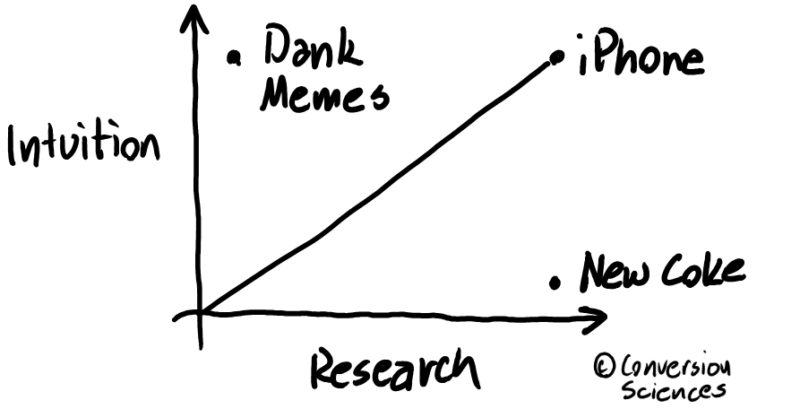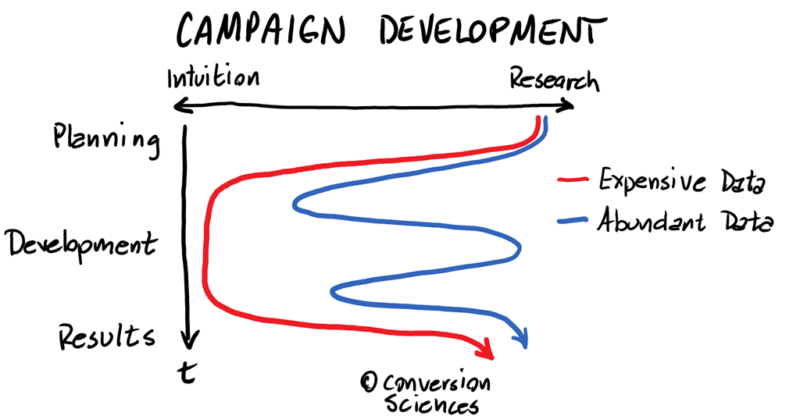Cheap data: You are about to get so much better at marketing
As data becomes ever more abundant and cheaper, columnist Brian Massey takes a look at what marketers stand to gain from the trend and what we can expect to see in 2017.

In 2012, my agency, Conversion Sciences, completed an eye-tracking study of video. To complete that study, we sought 25 random individuals, equally mixed by gender, to watch an eight-minute video and complete a survey.
The infared camera and software were relatively inexpensive, at $7,500. We used an email campaign over a month to find and schedule participants. Each was given a copy of my book, a $10 cost. We rented a room for two days, and a lab attendant was required the entire time. It was me, and I’m very expensive. It took over a week to compile the output of the eye-tracking camera and analyze it.
All in all, this test cost us between $15,000 and $25,000. (If you want to see our video eye-tracking report, click here.)
Last week, I ran an eye-tracking test for one of my client’s landing pages. I commissioned it in the morning and went on with my day’s work. Within a week, a panel of 25 participants had completed my study. The results were tabulated, and a variety of reports and videos gave me amazing insights into what was wrong with the page.
We paid eye-tracking firm Sticky.ai about $250.
Something has changed. While we all had our heads down, positioning products, creating campaigns, managing vendors and agonizing over copy, something definitely changed.
In 2016, global brands continued to brand themselves. Marketing departments continued to do more with fewer resources. Small businesses continued to try anything and everything. The hustle of everyday life continued. But something was different.
All at once, behavioral data became more accurate, easier to generate and much cheaper. Like Moore’s law on steroids, data has walked up to our collective door, introduced itself and offered to pay us to get to know it. It wants us to do some science with it. Data just can’t help itself.
Why is this such a boon for marketers? It means we can learn faster about our visitors. It means we can stop agonizing about how to position a product and just go find out. It means that we can stop guessing about what our prospects want and start asking. Every day.
From intuition to research
Great marketers are often heralded for their intuition. Intuition is important when data is expensive. Many of our most celebrated campaigns seem to have come from nowhere. However, many more of our campaigns based on intuition have failed miserably.

Balancing intuition and research. Inspired by Indexed.
The success rate of a purely intuitive campaign looks statistically like random luck.
When data gets cheap, research can play a bigger role, complementing creativity and intuition. The campaign development cycle changes as well.

Why should intuition get all of the attention?
When data is scarce, we do a lot of initial research, and then learn from our results. When data is abundant, we can spend more cycles on research and learn more from our results. When data is cheap, we test mockups, prototypes and draft versions of our campaigns. Because we can.
With this approach, we are much more likely to “get lucky.”
Why data is getting better
Abundant data is better data. Everything about it is more delicious. Here are the trends in the kinds of data we are using to drive our businesses.
From smaller samples sizes to larger sample sizes
Intuitive campaign development involves one person. If we include the team, we might have a handful of inputs. If we run a focus group or survey, we can get the input of dozens. When we move to behavioral analytics, we are involving hundreds or thousands of people in our development process.
From self-reported input to behavioral input
When we ask a survey panel or focus group what they think of our creative, they will lie. Humans are very good at rationalizing their decisions, but few know the real psychological reasons why they act the way they do. Behavioral input is an observation of people as they act. We don’t necessarily have to ask them why they do something. We can watch.
From less-recent to more-recent data
Market research takes time and effort. Most marketing studies are months old before they can be applied to a campaign. As the time and cost of research drops, we can perform studies more often and with more precision.
From data collected at one point in time to data spanning months and years of data
Most market research measures a point in time. It may be applicable over a longer period of time, but it is subject to historical errors by definition. Behavioral data can be collected constantly and over long periods of time. With just a few lines of code on your website, your analytics software builds a very helpful behavioral database day and night.
From periodic to real-time collection
When it is expensive to do research, we can’t afford to invest very often. Digital data gathering has become very inexpensive, and it allows us to capture what is happening on our websites, advertising networks and mobile apps in real time.
From qualitative to quantitative data
Qualitative collection methods allow us to drill down with a few subjects to understand more about their emotions and motivations. We don’t know if these emotions and motivations are representative of the broader market. Quantitative data gives us more statistical confidence that what we are seeing represents the larger market. However, this data isn’t seasoned with human interaction. Both are important.
From strangers to prospects and customers
When launching surveys, taste tests and focus groups, we try to get a representative sample of individuals, but they aren’t necessarily like our prospects. Behavioral data, by definition, is gathered from the activities of prospects and customers as they interact with our digital properties.
A new year with cheap data
Simon Grabowski, the CEO of GetResponse, listed five big challenges digital marketers faced in 2016 in an Entrepreneur.com article. The list included “Marketers are stuck on data collection.” I agree. Also on his list was “Marketing software is too hard to use.” I think he’s right there, too.
And I think we will overcome these issues. Why?
- The cost of collecting data is now less than the cost of not collecting data.
- Organizations are throwing money at anyone who knows how to apply this data.
- The tools are maturing.
In 2017, we will see a move from growth hacking to everyday behavioral science. Growth hacking is done by an independent team. Everyday behavioral science is done by everyone: marketing, sales, customer service.
Everyday behavioral data frees resources by eliminating unproductive programs before they are launched. In 2017, train your teams in basic data science and make it a part of their daily practice.
Contributing authors are invited to create content for MarTech and are chosen for their expertise and contribution to the search community. Our contributors work under the oversight of the editorial staff and contributions are checked for quality and relevance to our readers. MarTech is owned by Semrush. Contributor was not asked to make any direct or indirect mentions of Semrush. The opinions they express are their own.
Related stories